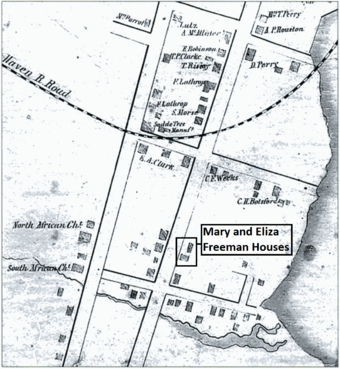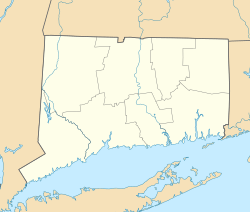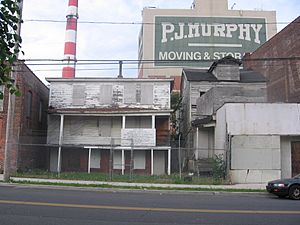Mary and Eliza Freeman Houses facts for kids
Quick facts for kids |
|
|
Mary and Eliza Freeman Houses
|
|

Little Liberia in 1850--the houses of the African American community are delineated by the absence of their owners' names
|
|
| Location | 352-4 and 358-60 Main St., Bridgeport, Connecticut |
|---|---|
| Built | 1848 |
| Architectural style | Italian Villa, Greek Revival |
| NRHP reference No. | 99000110 |
| Added to NRHP | February 22, 1999 |
The Mary and Eliza Freeman Houses are two important historic homes in Bridgeport, Connecticut. Built in 1848, these simple wooden houses were part of a special neighborhood called Little Liberia. This area was settled by free black people who were not enslaved. These houses are the last ones standing from that community on their original spots. They are also the oldest homes in Connecticut built by free black people before slavery officially ended in the state in 1848. Because of their history, they were added to the National Register of Historic Places in 1999. They are also part of the Connecticut Freedom Trail, along with the nearby Walter's Memorial A.M.E. Zion Church.
Contents
The Historic Freeman Houses
The Mary and Eliza Freeman Houses show a mix of old and new styles. They are built of wood and sit on tall stone basements. This was needed because they are close to the shore.
Mary's House: A Double Home
Mary's house was built first, starting in April 1848. It was finished by September of that year. It has an Italianate style, which was popular then. This house is a "double house," meaning it has two separate living areas. It has four windows across the front and two stories above a basement. A porch runs along the front. Inside, many original parts like doors and fireplaces are still there. It seems it might have started as one home, with the southern part added later.
Eliza's House: A Greek Revival Style
Eliza's house began construction in September 1848 and was finished that fall and winter. It has a Greek Revival style, with three windows across the front. Around 1862, a small attic window was added in a Victorian Gothic style. A shop was added to the front in 1903, but it was removed in 2013. A fire damaged the inside in the late 1980s. However, enough of the original house remains for it to be fully restored.
The Freeman Sisters: Mary and Eliza
The original owners were sisters, Mary (1815-1883) and Eliza (1805–1862) Freeman. They were free African American women born in Derby, Connecticut. Derby was a key place for free black people in Connecticut at that time.
In 1848, the sisters bought two building lots in Bridgeport. They had the houses built and rented them out. At first, they continued to live and work in New York City. Eliza returned to Bridgeport around 1855, working as a domestic helper. Mary, who was a hotel chef, followed her around 1861. Both sisters became quite successful and well-respected in their community. Mary's obituary in 1883 noted she had saved a lot of money and owned several houses.
Little Liberia: A Community of Freedom
Little Liberia was a special neighborhood in Bridgeport. It was first settled by African Americans in 1821. This was a time when free black people created their own communities in cities across the Northeast. They did this to find social and economic progress. Other similar communities grew in places like New Haven, Norwich, and Boston.
Why "Little Liberia"?
The name "Little Liberia" came from the people living there. They felt a connection to the new African colony of Liberia. This colony was created in the early 1800s for free black people and formerly enslaved people from America.
Building the Community
Joel Freeman (1795-1865), Mary and Eliza's brother, was important to the community. In 1831, he bought land and moved a building there to be his home. In 1828, he helped start Zion Church. This was Fairfield County's first African American church. The church built its own home in 1835. Later, this church became known as Walters Memorial African Methodist Episcopal Zion Church. It is believed to have been a stop on the Underground Railroad. The Underground Railroad was a secret network that helped enslaved people escape to freedom.
The Stratfield Special School for Colored Children was built in 1845. Joel Freeman helped get state money for this school. By 1850, maps showed two churches on Broad Street, both important to the community.
Life in Little Liberia
In 1998, a 104-year-old resident described Little Liberia. She said it was a "close-knit, safe African-American community." She remembered that family life was highly respected. The community spirit was strong, even during tough times.
This community was first called "Ethiope." It grew into a village of free black people, Native Americans, and Haitians. Besides churches and a school, it had its own businesses and a free library. There was even a seaside hotel that welcomed wealthy African American visitors. People from Little Liberia stayed connected with other free black communities. They hosted speakers from places like New York City.
For example, in 1895, the speaker Willis Augustus Hodges visited. He had been an abolitionist (someone who worked to end slavery) in Brooklyn, New York. He spoke to the "Young Colored Men's Republican Club" in Bridgeport. He warned them not to be tricked by politicians who worked against black people's rights. At that time, many laws were being passed in the South to stop black people from voting.
Preserving the Freeman Houses
By 2010, the two Freeman houses had been empty for a long time. Some thought they were about to fall apart. However, when old additions were removed in 2013, it showed the houses were still strong.
Bridgeport's Mayor, Bill Finch, announced money to help save the houses. A new group, the Mary & Eliza Freeman Center for History and Community, started raising funds. Their goal is to turn the houses into a museum. This museum would be open to school groups, historical tours, and researchers. The city sold the houses to the Freeman Center, helping to clear up past issues. This means these important homes can be saved and shared with future generations.




